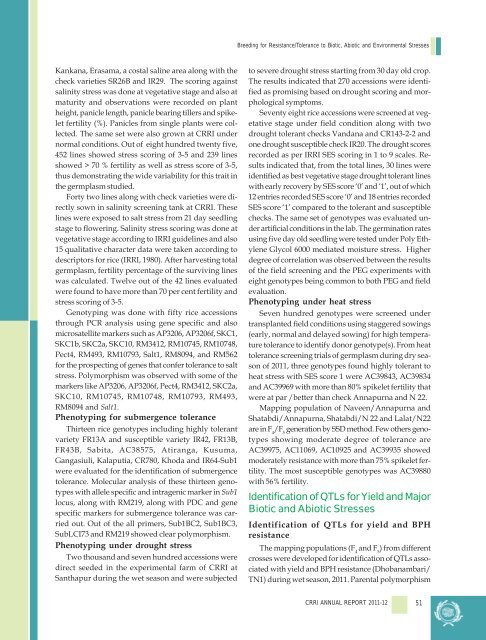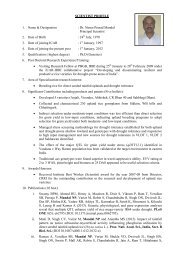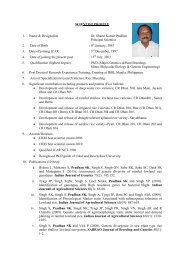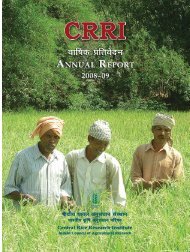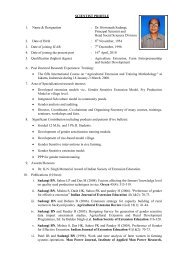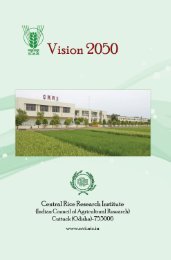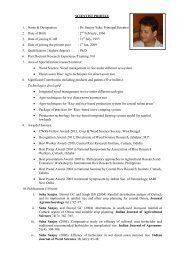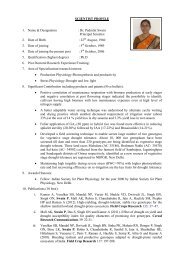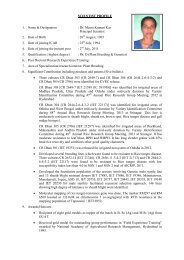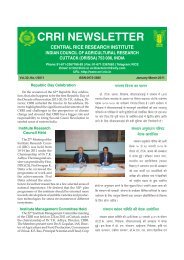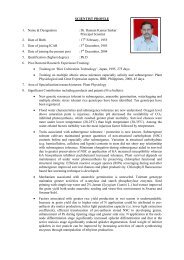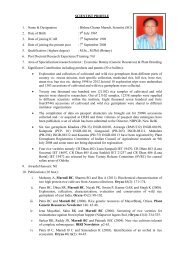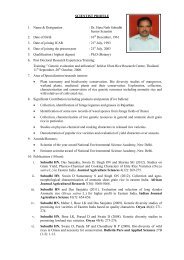Central Rice Research Institute Annual report...2011-12
Central Rice Research Institute Annual report...2011-12
Central Rice Research Institute Annual report...2011-12
You also want an ePaper? Increase the reach of your titles
YUMPU automatically turns print PDFs into web optimized ePapers that Google loves.
Breeding for Resistance/Tolerance to Biotic, Abiotic and Environmental Stresses<br />
Kankana, Erasama, a costal saline area along with the<br />
check varieties SR26B and IR29. The scoring against<br />
salinity stress was done at vegetative stage and also at<br />
maturity and observations were recorded on plant<br />
height, panicle length, panicle bearing tillers and spikelet<br />
fertility (%). Panicles from single plants were collected.<br />
The same set were also grown at CRRI under<br />
normal conditions. Out of eight hundred twenty five,<br />
452 lines showed stress scoring of 3-5 and 239 lines<br />
showed > 70 % fertility as well as stress score of 3-5,<br />
thus demonstrating the wide variability for this trait in<br />
the germplasm studied.<br />
Forty two lines along with check varieties were directly<br />
sown in salinity screening tank at CRRI. These<br />
lines were exposed to salt stress from 21 day seedling<br />
stage to flowering. Salinity stress scoring was done at<br />
vegetative stage according to IRRI guidelines and also<br />
15 qualitative character data were taken according to<br />
descriptors for rice (IRRI, 1980). After harvesting total<br />
germplasm, fertility percentage of the surviving lines<br />
was calculated. Twelve out of the 42 lines evaluated<br />
were found to have more than 70 per cent fertility and<br />
stress scoring of 3-5.<br />
Genotyping was done with fifty rice accessions<br />
through PCR analysis using gene specific and also<br />
microsatellite markers such as AP3206, AP3206f, SKC1,<br />
SKC1b, SKC2a, SKC10, RM34<strong>12</strong>, RM10745, RM10748,<br />
Pect4, RM493, RM10793, Salt1, RM8094, and RM562<br />
for the prospecting of genes that confer tolerance to salt<br />
stress. Polymorphism was observed with some of the<br />
markers like AP3206, AP3206f, Pect4, RM34<strong>12</strong>, SKC2a,<br />
SKC10, RM10745, RM10748, RM10793, RM493,<br />
RM8094 and Salt1.<br />
Phenotyping for submergence tolerance<br />
Thirteen rice genotypes including highly tolerant<br />
variety FR13A and susceptible variety IR42, FR13B,<br />
FR43B, Sabita, AC38575, Atiranga, Kusuma,<br />
Gangasiuli, Kalaputia, CR780, Khoda and IR64-Sub1<br />
were evaluated for the identification of submergence<br />
tolerance. Molecular analysis of these thirteen genotypes<br />
with allele specific and intragenic marker in Sub1<br />
locus, along with RM219, along with PDC and gene<br />
specific markers for submergence tolerance was carried<br />
out. Out of the all primers, Sub1BC2, Sub1BC3,<br />
SubLCI73 and RM219 showed clear polymorphism.<br />
Phenotyping under drought stress<br />
Two thousand and seven hundred accessions were<br />
direct seeded in the experimental farm of CRRI at<br />
Santhapur during the wet season and were subjected<br />
to severe drought stress starting from 30 day old crop.<br />
The results indicated that 270 accessions were identified<br />
as promising based on drought scoring and morphological<br />
symptoms.<br />
Seventy eight rice accessions were screened at vegetative<br />
stage under field condition along with two<br />
drought tolerant checks Vandana and CR143-2-2 and<br />
one drought susceptible check IR20. The drought scores<br />
recorded as per IRRI SES scoring in 1 to 9 scales. Results<br />
indicated that, from the total lines, 30 lines were<br />
identified as best vegetative stage drought tolerant lines<br />
with early recovery by SES score ‘0’ and ‘1’, out of which<br />
<strong>12</strong> entries recorded SES score ‘0’ and 18 entries recorded<br />
SES score ‘1’ compared to the tolerant and susceptible<br />
checks. The same set of genotypes was evaluated under<br />
artificial conditions in the lab. The germination rates<br />
using five day old seedling were tested under Poly Ethylene<br />
Glycol 6000 mediated moisture stress. Higher<br />
degree of correlation was observed between the results<br />
of the field screening and the PEG experiments with<br />
eight genotypes being common to both PEG and field<br />
evaluation.<br />
Phenotyping under heat stress<br />
Seven hundred genotypes were screened under<br />
transplanted field conditions using staggered sowings<br />
(early, normal and delayed sowing) for high temperature<br />
tolerance to identify donor genotype(s). From heat<br />
tolerance screening trials of germplasm during dry season<br />
of 2011, three genotypes found highly tolerant to<br />
heat stress with SES score 1 were AC39843, AC39834<br />
and AC39969 with more than 80% spikelet fertility that<br />
were at par /better than check Annapurna and N 22.<br />
Mapping population of Naveen/Annapurna and<br />
Shatabdi/Annapurna, Shatabdi/N 22 and Lalat/N22<br />
are in F 4<br />
/F 5<br />
generation by SSD method. Few others genotypes<br />
showing moderate degree of tolerance are<br />
AC39975, AC11069, AC10925 and AC39935 showed<br />
moderately resistance with more than 75% spikelet fertility.<br />
The most susceptible genotypes was AC39880<br />
with 56% fertility.<br />
Identification of QTLs for Yield and Major<br />
Biotic and Abiotic Stresses<br />
Identification of QTLs for yield and BPH<br />
resistance<br />
The mapping populations (F 4<br />
and F 5<br />
) from different<br />
crosses were developed for identification of QTLs associated<br />
with yield and BPH resistance (Dhobanambari/<br />
TN1) during wet season, 2011. Parental polymorphism<br />
CRRI ANNUAL REPORT 2011-<strong>12</strong><br />
51


